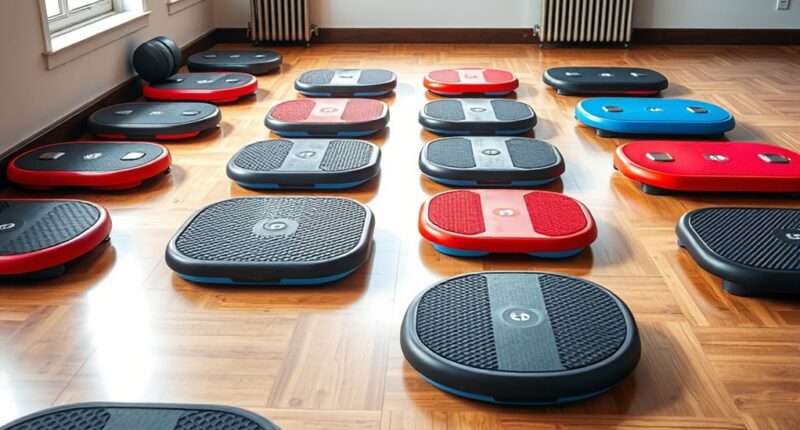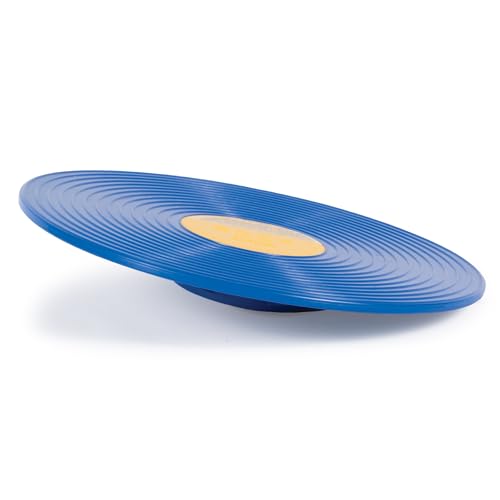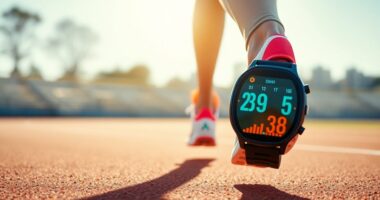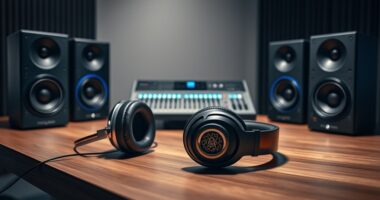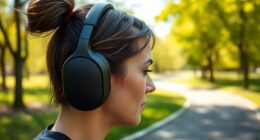If you’re looking to boost your proprioception and running performance, I recommend exploring some of the top balance boards available in 2025. These boards, like the MADOG Wobble Balance Board and Yes4All Trainer, are designed for stability, foot strength, and injury prevention. They feature non-slip surfaces, durable materials, and versatile functions to suit all skill levels. Keep exploring to discover which models can help elevate your training and keep you balanced.
Key Takeaways
- Top-rated balance boards support proprioception, core strength, and ankle stability, essential for improving running performance in 2025.
- Features like 360° rotation, tilting, and textured surfaces enhance dynamic balance and foot control for runners.
- Durable materials such as high-grade plywood and reinforced composites ensure longevity under regular training loads.
- Models with anti-slip and ergonomic designs provide safety and comfort during proprioception exercises.
- Versatile boards suitable for rehab, strength training, and athletic conditioning optimize running efficiency and injury prevention.
Mobo Board
If you’re looking to improve foot control and proprioception for enhanced athletic performance, the Mobo Board is an excellent choice. I’ve found that its unique Toe Box Technology and Anatomical Axis align perfectly with the natural shape of your foot, helping build a stable arch and better control. The design encourages syncing foot movements with hips and core, boosting overall stability and injury prevention. Made from durable plastic with a sleek bamboo finish, it supports up to 350 pounds. Using the Mobo Board regularly can markedly improve balance, coordination, and internal foot strength — all essential for excelling in sports and outdoor activities.
Best For: athletes and outdoor enthusiasts seeking to improve foot control, balance, and proprioception for enhanced performance and injury prevention.
Pros:
- Aligns with natural foot architecture using Toe Box Technology and Anatomical Axis for optimal stability
- Supports up to 350 pounds, making it suitable for a wide range of users
- Promotes improved balance, coordination, and internal foot strength for better athletic performance
Cons:
- Made from plastic, which may be less durable over extended heavy use compared to other materials
- Requires regular use for noticeable improvement, which may not appeal to casual users
- Potentially limited for indoor use if not used on appropriate surfaces
Amazon Basics Wood Wobble Balance Trainer Board
The Amazon Basics Wood Wobble Balance Trainer Board stands out as an excellent choice for beginners and seasoned exercisers alike who want to improve core strength, coordination, and stability. Its solid wood surface supports up to 265 pounds and features a non-slip grip, ensuring safety during various exercises. Measuring 15.75 inches squared and just over 3 inches high, it’s compact yet versatile. You can use it for push-ups, planks, balance poses, or targeted strengthening routines for muscles, ligaments, tendons, and joints. Whether at home, in a gym, or rehab setting, this board helps enhance stability, posture, and overall coordination effectively. Plus, it comes with a 1-year warranty for peace of mind.
Best For: individuals of all fitness levels seeking to improve core strength, balance, and posture through versatile, low-impact exercises at home, in the gym, or in rehab settings.
Pros:
- Solid wood construction supports up to 265 pounds for durable use
- Non-slip surface ensures safety and secure grip during workouts
- Compact size (15.75″ x 15.75″ x 3.15″) makes it easy to store and versatile for various exercises
Cons:
- May be too small for taller or larger users requiring more space
- Limited height (just over 3 inches) might restrict certain advanced balance exercises
- No adjustable features or incline options for varied training intensity
Yes4All Upgraded Wobble Balance Board
For those seeking a durable and versatile balance board that supports injury recovery and enhances functional strength, the Yes4All Upgraded Wobble Balance Board stands out. Its large 16.34-inch diameter provides ample space for both feet, while the high-grade TPE plastic guarantees durability and a weight capacity of up to 300 lbs. The anti-slip bottom and massage spikes on the surface improve grip and comfort. Its lightweight design with handles makes it easy to carry and use anywhere—home, outdoors, or at a standing desk. Perfect for rehab, core training, and balance exercises, this board offers reliable performance for users of all skill levels.
Best For: individuals seeking a durable, versatile balance board for injury recovery, core strengthening, and balance improvement suitable for all skill levels.
Pros:
- Large 16.34-inch diameter provides ample space for both feet, enhancing stability.
- Made from high-grade heavy-duty TPE plastic with a weight capacity of up to 300 lbs, ensuring durability.
- Lightweight with handles for easy portability and versatile use at home, outdoors, or at standing desks.
Cons:
- Maximum recommended weight is 28.6 pounds, which may limit use for very heavy users.
- Some users may find the massage spikes less comfortable during extended exercises.
- As a plastic balance board, it may not offer the same dynamic feel as wooden or more advanced balance equipment.
Yes4All Upgraded Wobble Balance Board
Looking for a balance board that combines durability with versatile functionality? The Yes4All Upgraded Wobble Balance Board is a great choice. It measures 16.34 inches in diameter, giving you ample foot space, and is made from high-grade TPE plastic that supports up to 300 pounds. Its sky blue color and handles make it stylish and portable. The padded massage spikes on top and bottom prevent slipping, boost comfort, and promote blood flow. Suitable for various exercises and rehab routines, it’s perfect for home, outdoor, or gym use. With a solid 4.7-star rating, this board is a reliable tool for improving balance, strength, and coordination.
Best For: individuals seeking a durable, versatile balance board for improving stability, strength, rehabilitation, and fitness routines at home, outdoors, or in gyms.
Pros:
- Made from high-grade heavy-duty TPE plastic supporting up to 300 pounds for durability and safety
- Features massage spikes on top and bottom to prevent slipping, enhance comfort, and promote blood flow
- Includes handles for portability, making it easy to use in various settings and for different exercises
Cons:
- Slightly larger footprint may require more space for certain users
- The upscale style and color may not appeal to all aesthetic preferences
- The price may be higher compared to basic balance boards with fewer features
OPTP Rock Ankle Exercise Board for Therapy and Rehab
If you’re seeking a reliable tool for therapy and rehab, the OPTP Rock Ankle Exercise Board stands out because of its long-standing reputation among professionals. I’ve used it for improving ankle strength, balance, and proprioception through various exercises like tilts, single-leg balances, and calf raises. Its flattened sphere base guarantees smooth progression, making it suitable for all skill levels. It’s lightweight, durable, and supports up to 240 pounds, which adds to its versatility. Whether at home, in the clinic, or on the go, I find it safe, easy to use, and highly effective for active rehabilitation and improving lower limb stability.
Best For: individuals seeking a versatile, reliable balance and ankle rehabilitation tool suitable for therapy, rehab, and strength training at home, in clinics, or on the go.
Pros:
- Enhances proprioception, balance, and ankle strength through various dynamic exercises.
- Features a flattened sphere base for smooth, safe movement suitable for all skill levels.
- Lightweight, durable, and supports up to 240 pounds, making it portable and versatile for multiple settings.
Cons:
- Maximum tilt of 18 degrees may limit some advanced balance training.
- Not designed for heavy-duty or high-impact activities beyond rehab and light strength training.
- Requires some familiarity to perform exercises safely and effectively, especially for beginners.
Balance Board for Adults, Anti-Slip Wobble Board with 350LBS Capacity
This anti-slip wobble board stands out as the top choice for adults seeking a durable and secure balance training tool, thanks to its impressive 350-pound weight capacity. Made from high-quality materials, it offers a stable, slip-resistant surface with protective pads to prevent floor damage. Its compact, lightweight design makes it easy to carry and store at home, the gym, or the office. Perfect for beginners, seniors, and rehab patients, it enhances stability, coordination, and core strength. Whether for physical therapy or advanced workouts like squats and push-ups, this wobble board provides safe, versatile training for all skill levels.
Best For: adults of all skill levels, including beginners, seniors, and rehab patients, seeking a durable, safe, and versatile balance training tool.
Pros:
- Supports up to 350 lbs, making it suitable for a wide range of users.
- Features an anti-slip surface and protective pads for safety and floor protection.
- Compact and lightweight, easy to transport and store for use at home, gym, or office.
Cons:
- May require additional accessories for advanced exercises or specific therapy routines.
- Limited color or design options may not suit all aesthetic preferences.
- Usage effectiveness depends on user commitment and proper technique.
Wooden Wobble Board for Adults
The Wooden Wobble Board for Adults stands out as an excellent choice for those seeking a durable, stable, and versatile balance board. Made of wood with no assembly required, it features a reinforced bottom strip for added stability and supports up to 350 pounds. Its anti-slip surface guarantees a secure grip, reducing fall risk, while anti-scratch pads protect floors and keep noise levels low. Perfect for home, gym, or office use, it helps improve core strength, motor coordination, and balance. Whether you’re a beginner or recovering from injury, this board offers a safe, effective way to enhance stability and posture in everyday activities.
Best For: individuals seeking a durable, stable balance board for improving core strength, balance, and posture at home, in the gym, or in the office.
Pros:
- Made of high-quality wood with no assembly required for easy setup and use
- Supports up to 350 pounds with reinforced bottom strip for added stability
- Equipped with anti-slip surface and anti-scratch pads for safety and floor protection
Cons:
- Limited color options, primarily in basic wood finish
- Slightly heavier weight (2.01 kg), which may be less portable for travel
- May require additional accessories or routines to maximize balance training effectiveness
EVERYMILE Wobble Balance Board for Exercise and Therapy
For those seeking a versatile and durable balance board suitable for both exercise and therapy, the EVERYMILE Wobble Balance Board stands out. Its 15.7-inch abrasion-resistant ABS platform features a textured, no-slip surface, supported by six non-skid feet and a built-in handle for portability. Supporting up to 300 lbs and weighing just 3.5 lbs, it’s perfect for adults and kids. The 360-degree rotation and 15-degree tilt allow for dynamic drills that improve balance, coordination, and core strength. Made from sturdy plastic and TPR, it performs well on various surfaces like carpet, hardwood, or tile, making it ideal for workouts, rehab, and everyday use.
Best For: individuals seeking a versatile, durable balance board for fitness, physical therapy, rehabilitation, and everyday balance improvement for all age groups.
Pros:
- Supports up to 300 lbs while remaining lightweight at 3.5 lbs for easy transport and use
- Durable construction with abrasion-resistant ABS and TPR materials for long-term use on various surfaces
- Enhances balance, coordination, and core strength through 360-degree rotation and tilt drills
Cons:
- Some users find the surface slippery; wearing shoes or socks improves grip
- The size (15.7 inches) may be small for larger exercises or users requiring a bigger platform
- A few users mention it can feel slightly tippy or unstable during advanced movements
StrongTek Wooden Balance Board for Under Desk Core Strength and Stability
If you’re looking to boost your core strength and stability discreetly at work, the StrongTek Wooden Balance Board is a top choice. Its large, sustainably sourced Lauan hardwood plywood surface measures 17.5 x 13.5 inches, with a 3-inch height and a cross-shaped base that allows 360° rotation and tilting. Designed for safety, it features a non-slip surface and base, supporting up to 350 pounds. Perfect for office use, it helps improve balance, coordination, and muscle stabilization through dynamic movements like squats, lunges, and planks. Whether for fitness or rehab, this durable board offers an effective, versatile way to strengthen your core without leaving your desk.
Best For: individuals seeking to improve core strength, stability, and coordination discreetly at work or during rehabilitation, suitable for fitness enthusiasts, office workers, and physical therapy patients.
Pros:
- Large, sustainably sourced Lauan hardwood surface for stability and durability
- 360° rotation and tilting for versatile, advanced core training
- Supports up to 350 pounds, making it suitable for a wide range of users
Cons:
- May require a flat, non-carpeted surface for optimal stability
- Slightly larger size may be less portable for travel or small spaces
- Some users might find the initial balancing challenge difficult without prior practice
Ankle Balance Board & Foot Strengthener for Balance Training
Designed with adjustable movable panels and Velcro balance bars, the Ankle Balance Board & Foot Strengthener offers customizable training that targets various foot muscles. Its tilt and twist movements help improve ankle strength, stability, flexibility, and control. Ideal for relieving foot issues like ankle sprains, plantar fasciitis, and Achilles tendonitis, it promotes better gait and reduces pain over time. Made from durable birch plywood with anti-slip pads, it’s safe and reliable for high-intensity workouts or rehab. Supporting up to 400 pounds, it’s perfect for athletes, therapists, or anyone seeking improved foot health, balance, and injury prevention—whether at home, gym, or on the go.
Best For: athletes, physical therapy patients, and fitness enthusiasts seeking to improve ankle strength, balance, and foot health through customizable and safe training.
Pros:
- Adjustable movable panels and Velcro bars allow personalized targeting of foot muscles.
- Durable construction from high-quality birch plywood with anti-slip pads ensures safety and longevity.
- Supports up to 400 pounds, suitable for various fitness levels and intense workouts.
Cons:
- Slightly higher price point compared to basic balance boards.
- May require some setup time to customize panels and bars for specific exercises.
- Limited color options, primarily in neutral tones, which may not appeal to all users.
Ankle Balance Board Foot Strengthener
The Ankle Balance Board Foot Strengthener stands out as an ideal choice for anyone recovering from foot injuries or seeking to improve ankle stability. I’ve found it effective for strengthening ankle muscles, alleviating pain, and supporting rehab from sprains, plantar fasciitis, or Achilles issues. Its multi-position balance bars target specific foot zones, enhancing control and stability. Made from durable birch plywood with a non-slip surface, it’s safe and comfortable to use. The lightweight, portable design allows me to train anywhere—home, outdoors, or at work. If you want to boost foot health and prevent injuries, this board is a versatile, reliable tool.
Best For: individuals recovering from foot injuries or looking to improve ankle stability and foot strength through targeted balance training.
Pros:
- Enhances ankle stability and overall foot health through multi-position balance bars
- Made from durable birch plywood with a non-slip, skin-friendly surface for safety and comfort
- Lightweight and portable, ideal for use at home, outdoors, or at work
Cons:
- Limited color options (mainly wood and black) may not appeal to all preferences
- Slightly smaller dimensions may require careful placement during exercises
- Customer ratings are moderate, indicating room for improvement or varied user experiences
Balance Board Wooden Wobble Board for Adults
The VANKUTL Wooden Wobble Board stands out as the top choice for adults seeking a durable, versatile balance tool. Made from high-quality plywood, it supports up to 350 pounds, making it suitable for various users. Its anti-slip pads ensure a secure grip on the ground, reducing fall risks, while anti-scratch pads minimize wear and noise indoors. Compact and lightweight at just under 2 kg, it’s easy to move and store. I’ve found it perfect for improving core strength, posture, and balance, whether during rehab, physical therapy, or daily movement. Its multifunctionality makes it a practical addition to any fitness or recovery routine.
Best For: Adults seeking a durable, versatile balance board for physical therapy, core training, or daily movement enhancement.
Pros:
- Supports up to 350 pounds, suitable for a wide range of users.
- Features anti-slip and anti-scratch pads for safety and durability.
- Compact, lightweight design makes it easy to store and transport.
Cons:
- May be less suitable for children or very lightweight users due to its size and weight capacity.
- Requires a flat surface for optimal stability during use.
- Limited color options, primarily available in black.
MADOG Wobble Balance Board for Adults
If you’re looking for a versatile balance board that supports both fitness and rehabilitation, the MADOG Wobble Balance Board for Adults stands out with its 360° rotation and 15° tilting angle. It’s made of durable PP plastic and TPR, supporting up to 330 pounds, making it suitable for all ages. Its compact design, dual handles, and anti-skid surface make it easy to transport, use at home, outdoors, or at the office. This board effectively improves balance, coordination, and core strength while serving as a rehabilitation tool for ankle, knee, or hip recovery. Users praise its sturdiness, though some note the surface can be slippery on hard floors.
Best For: individuals seeking a durable, versatile balance board for fitness, core training, or rehabilitation purposes suitable for all ages and fitness levels.
Pros:
- Supports up to 330 pounds, accommodating a wide range of users
- 360° rotation and 15° tilting for comprehensive balance and core exercises
- Portable with dual handles and anti-skid surface for safe, easy transport and use
Cons:
- Surface may be slippery on hard floors, requiring additional grip measures
- The size might be small for taller users or those with larger feet, affecting balance
- Some users report safety concerns like slipping or toe pinching during use
Ankle Balance Board for Stability & Foot Strengthening
For anyone seeking to improve ankle stability and strengthen foot muscles, the Ankle Balance Board from FDAKIT stands out as an excellent choice. It’s designed for recovery, stability training, posture correction, plantar fasciitis relief, and everyday fitness. Supporting up to 330 pounds, it’s suitable for all users. The adjustable resistance with multiple rods allows you to customize your workouts for strength, agility, or recovery. Its compact, lightweight design makes it easy to carry and use anywhere—home, gym, or travel. Made from durable reinforced wood-plastic composite, it offers long-lasting stability and natural tactile feedback, ensuring safe and effective training.
Best For: athletes, rehab patients, and daily fitness enthusiasts seeking to improve ankle stability, foot strength, and posture correction.
Pros:
- Adjustable resistance with multiple rods allows for personalized workout intensity.
- Durable reinforced wood-plastic composite construction ensures long-lasting stability.
- Compact and lightweight design enhances portability for use at home, gym, or during travel.
Cons:
- Limited dimensions may not accommodate users with larger feet comfortably.
- Requires balance and coordination; may be challenging for complete beginners.
- No electronic features or digital feedback for performance tracking.
Yes4All Balance Board Sports Trainer
Designed to support users of all skill levels, the Yes4All Balance Board Sports Trainer stands out with its adjustable stoppers, which let me customize the difficulty easily. I appreciate how I can switch between 11, 16, or 22 inches, making it suitable for beginners or advanced users. The durable 15-ply pressed wood supports up to 300 lbs and features a non-slip emery surface, ensuring safety. The TPE-covered roller glides smoothly, adding to the challenge. Whether I’m training for surfing, snowboarding, or just improving balance, this versatile board adds fun and effectiveness to my routine, all while being easy to adjust for my skill level.
Best For: individuals of all skill levels looking to improve balance, core strength, and coordination across various sports and fitness routines.
Pros:
- Adjustable stoppers allow for customizable difficulty levels suitable for beginners and advanced users
- Durable construction with support for up to 300 lbs and slip-resistant surface for safety
- Versatile design supports training for multiple sports and activities while adding fun to workouts
Cons:
- Magnetized stoppers may protrude or become dislodged over time
- Slightly larger size may require adequate space for safe use
- Some users might find the need for occasional maintenance or replacement of parts
Factors to Consider When Choosing Balance Boards Proprioception Runners
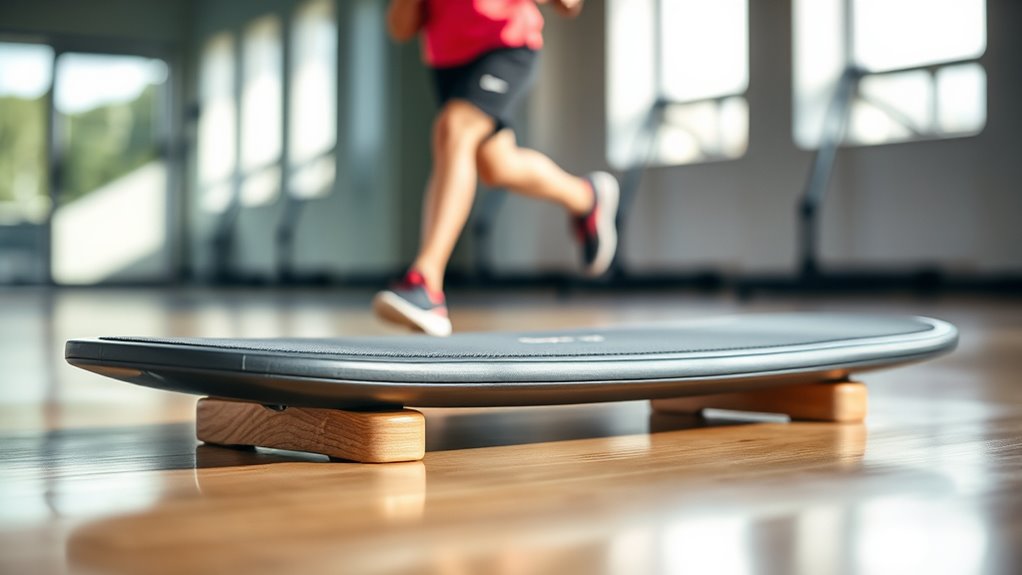
When selecting a balance board for proprioception and running, I consider factors like the material, weight capacity, and surface traction to guarantee safety and durability. Size and foot space matter too, so I can comfortably perform exercises without feeling cramped. Plus, portability and storage options help me choose a board that’s easy to use anywhere and fits my space.
Balance Board Material
Choosing the right material for a balance board is essential because it directly affects durability, grip, and safety. Wood-based boards provide natural tactile feedback, are strong, and have a classic look, supporting weights up to 350 pounds. Plastic or composite boards, made from ABS or TPE, are lightweight, highly durable, and resistant to moisture and wear, making them ideal for various environments. Adding rubber or anti-slip coatings enhances grip, preventing slips during sweaty or dynamic exercises, and improves safety. The material also influences the board’s weight, portability, and suitability for indoor or outdoor use. Overall, selecting the right material guarantees your balance board remains effective, safe, and long-lasting as you work on proprioception and running performance.
Weight Capacity Range
Selecting a balance board with the right weight capacity is vital to guaranteeing safety and durability during your proprioception and running exercises. Most boards support between 265 and 350 pounds, so choosing one that matches your body weight is essential. For heavier users or those doing high-impact routines, a higher weight capacity offers better safety margins and longevity. I recommend selecting a board that exceeds your body weight by at least 20%, accounting for dynamic movements and safety. Using a board with a lower weight limit can pose safety risks or cause premature wear. Always check the manufacturer’s specified weight limit before purchasing. Properly matching your weight ensures effective training while preventing equipment failure, helping you get the most out of your balance and proprioception exercises.
Surface Traction Features
A secure grip is essential for effective balance training, so paying attention to surface traction features can make a big difference. I look for balance boards with textured, non-slip surfaces crafted from materials like TPR or rubber, which guarantee steady footing. Anti-slip pads or coatings on the top surface are a plus, especially when sweating or barefoot. I also prefer boards with textured features like ridges or massage spikes that increase friction and prevent slipping during dynamic movements. It’s important that the surface design offers consistent traction across different flooring types, such as hardwood, tile, or carpet, making my training versatile. Additionally, choosing models with anti-skid feet or bottom pads helps stabilize the board and reduces the risk of sliding during exercises.
Size and Foot Space
When evaluating balance boards for proprioception training, I find that size and foot space play a crucial role in overall stability and comfort. A larger foot area, typically at least 15 inches in diameter, provides enough room for both feet to distribute weight evenly, which boosts stability and reduces the risk of losing balance. This is especially important for taller individuals or those with larger feet, since more space makes the exercises more comfortable and effective. Boards with ample foot space also allow for a wider range of exercises, like wide stance squats or multi-directional tilts, enhancing versatility. While smaller boards are more portable, they often limit movement options and decrease stability, particularly during advanced routines. Choosing the right size ensures safer, more effective proprioception training.
Portability and Storage
Portability and storage are key considerations when choosing a balance board for proprioception training, especially if I want to take it to the gym, outdoors, or store it easily at home. I look for models that are lightweight and compact, making them simple to carry and store in small spaces. Features like built-in handles or foldable components help me transport and disassemble the board quickly. Durable yet lightweight materials, such as high-grade plastics or thin plywood, strike the perfect balance between sturdiness and portability. I also pay attention to the size and weight of the board to guarantee it fits my storage options, particularly if I travel often or have limited space at home. A portable design makes consistent training more convenient and accessible.
Adjustment Difficulty Levels
Choosing a balance board with adjustable difficulty levels is essential for tailoring your proprioception training to your current skill and fitness level. These boards often feature removable stoppers, adjustable rollers, or customizable resistance, allowing you to easily modify the challenge. Multiple difficulty settings enable a smooth progression from basic balancing to more advanced stabilization exercises, supporting continuous improvement. They also accommodate users of different ages, fitness backgrounds, or rehab needs, making the board versatile. Clear indicators or easy-to-access adjustment mechanisms are important for quick changes during workouts or therapy sessions. Importantly, balancing difficulty with safety ensures you can push your limits without risking injury or overexertion. This adaptability makes adjustable balance boards a smart choice for ongoing, safe proprioception development.
Therapeutic Benefits Focus
Therapeutic balance boards offer significant benefits for improving proprioception, which is essential for injury prevention and recovery. They stimulate sensory receptors in muscles, joints, and skin, enhancing body awareness and coordination. Regular use helps retrain neural pathways, resulting in better motor control and reduced injury risk. The tilting and rocking motions promote joint stability and strengthen stabilizer muscles, supporting rehabilitation efforts. Incorporating balance boards into therapy can boost confidence in balance and lower fall risk, especially for elderly or recovering individuals. The proprioceptive improvements gained through this training also translate into enhanced athletic performance and better functional movement in daily life. When selecting a balance board, consider its ability to target sensory feedback and support therapeutic goals, ensuring it aligns with your recovery or training needs.
Durability and Construction
When selecting a balance board for proprioception training, focusing on durability and construction is vital to guarantee it withstands regular use. I look for high-quality materials like durable wood, heavy-duty plastics, or plywood, which assure longevity and resist wear and tear. Reinforced features such as double reinforcement strips or cross-shaped bases add stability and prevent breakage during intense workouts. Anti-slip surfaces and pads not only keep me safe but also reduce damage to floors, extending the board’s lifespan. I also check the weight capacity—ideally supporting between 265 and 350 pounds—to make sure it’s robust enough for various users. Proper sealing, textured surfaces, and anti-scratch pads further protect the board from environmental damage, maintaining its structural integrity over time.
Frequently Asked Questions
How Do Balance Boards Improve Proprioception Specifically for Runners?
Balance boards enhance my proprioception by challenging my stability and coordination. As I practice on them, I become more aware of my body’s position and movement, which translates into better balance and control during running. The unstable surface forces me to engage smaller stabilizer muscles, improving my joint awareness and reaction time. This heightened proprioception helps me run more efficiently, avoid injuries, and maintain better form over long distances.
What Safety Features Should I Look for in a Balance Board?
When choosing a balance board, I look for safety features like non-slip surfaces and sturdy, wide bases to prevent slipping or wobbling. An anti-slip grip on the bottom is vital for stability, especially on smooth floors. I also prefer boards with adjustable difficulty levels so I can start slow and progress safely. Transparent weight limits help guarantee I pick one that supports my body comfortably and securely.
Can Balance Boards Help Prevent Ankle Injuries in Runners?
Did you know that ankle sprains are among the most common injuries in runners, accounting for about 30% of all running injuries? I believe balance boards can definitely help prevent ankle injuries by strengthening stabilizer muscles and improving proprioception. When I incorporate balance training into my routine, I notice better ankle stability and fewer twists. So, yes, using a balance board is a smart way to protect your ankles while running.
Are There Age-Specific Balance Boards for Different Skill Levels?
Yes, there are age-specific balance boards designed for different skill levels. I’ve seen boards tailored for kids, teens, and seniors, each with features suited to their abilities and safety needs. These boards help improve proprioception and balance gradually, making training more effective and enjoyable. Whether you’re a beginner or an advanced user, choosing a board suited to your age and skill level guarantees better results and reduces injury risk.
How Often Should I Incorporate Balance Training Into My Running Routine?
I recommend incorporating balance training into your running routine 2-3 times a week. I find that regular practice helps improve proprioception, stability, and overall performance. Just make sure to start slowly, especially if you’re new to balance exercises, and gradually increase intensity. Consistency is key, so find a routine that fits your schedule, and you’ll notice better control and reduced injury risk over time.
Conclusion
If you want to boost your proprioception and run stronger, choosing the right balance board is key. I believe that consistency and selecting a board that fits your needs can truly make a difference. When you find that perfect match, you’ll notice improved stability and performance over time. So, don’t just pick any—trust your instincts, stay committed, and watch your running game elevate naturally, almost like a rhythm syncing with your body.
